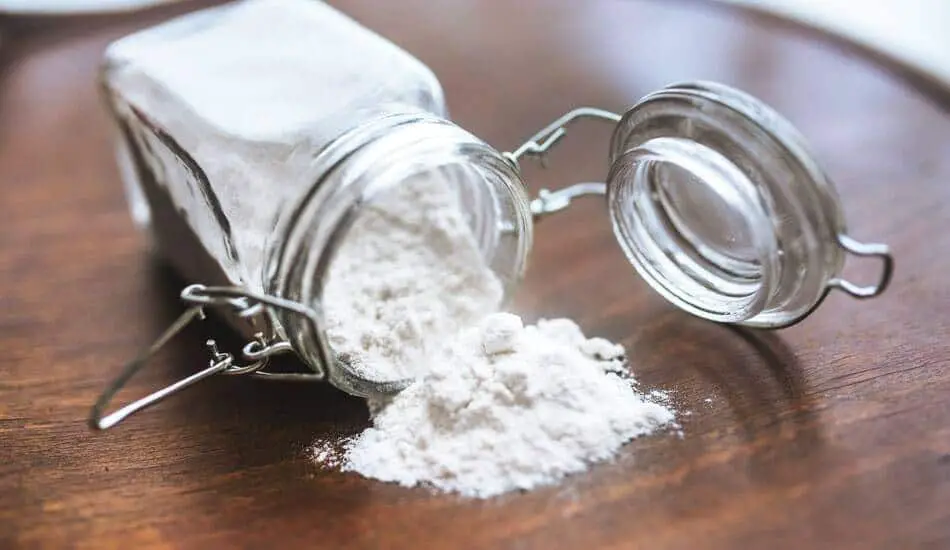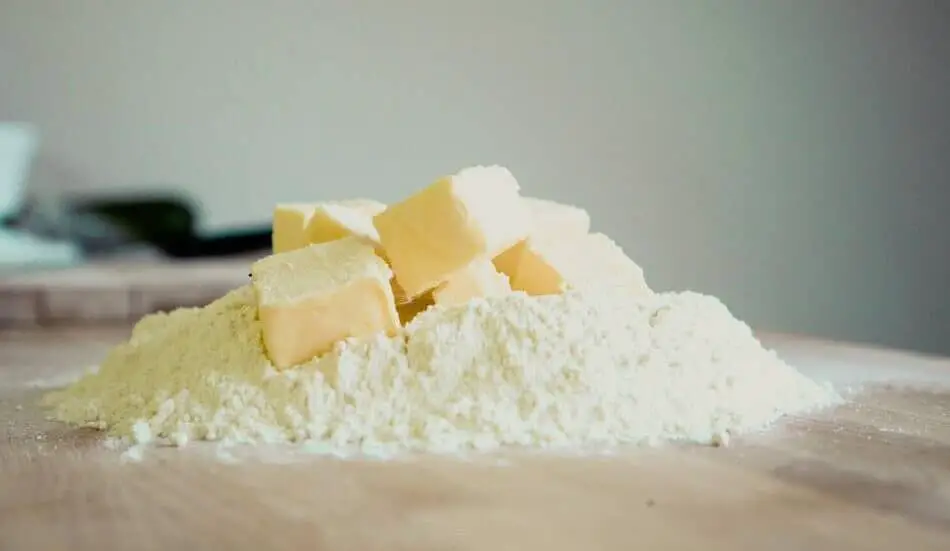A good sourdough bread is suppose to be chewy but never rubbery. The chewiness becomes more pronounced as the gluten structure in the sourdough is more developed;the gluten gives sourdough bread its strength and has a gum like consistency that becomes more chewy the longer you mix.
If you take a well develop dough and wash it down with water, what you will be left with is pure gluten network; all the starches and other ingredients of the dough would have been washed away. You can feel for yourself the rubbery consistency of pure gluten strands, it is elastic and stretchable.
In fact you can blow into it and it will expand just like a balloon. Sourdough bread with a stronger gluten network will result in a chewier crumb.
Factors that affect sourdough bread’s chewiness
1. Mixing and kneading develops gluten structure of dough
The act of mixing or kneading the dough aligns glutenin and gliadin protein found in the flour to form gluten network in the dough. The gluten network gives dough its strength and pliability as it has a rubbery like consistency.
The longer we mix, the more highly develop the gluten network becomes, and you will notice that that dough becomes stronger and stiffer, and the resulting baked loaf will be chewier in texture.
To increase the chewiness of your sourdough bread, add 1 to 2 more minutes to your mixing time.
To decrease the chewiness of your sourdough bread, reduce mixing time by 1 to 2 minutes.
2. Folding develops gluten structure
Another way of developing chewiness in our sourdough is to incorporate more folds during bulk fermentation. Folding the dough helps to stretch and align the glutenin and gliadin proteins to form gluten strand similar to the kneading and mixing action.
Typically for most sourdough bread recipes, 1 fold is sufficient for every hour of bulk fermentation; 1 fold consists of the folding of all four sides of the dough into its centre. Becareful not to incorporate too many folds as it can very quickly over strengthen your dough causing it to be too chewy.
To increase the chewiness of your sourdough bread, increase number of folds by 1.
To decrease the chewiness of your sourdough bread, decrease number of folds by 1.

3. Autolyse develops gluten structure without mechanical mixing
The autolyse process enables your sourdough to develop in gluten without any mechanical mixing. Autolyse is done by mixing only the flour and water together, without the addition of any other ingredients.
Once the flour and water is incorporated, the dough is then left to rest for 20 to 60 minutes. During that time the flour fully hydrates and gluten is developed; you will notice after the autolyse that the dough will have developed in strength considerably.
Since autolyse helps to develop gluten, it will make your sourdough more chewy in texture.
To increase the chewiness of your sourdough bread, use the autolyse method.
To decrease the chewiness of your sourdough bread, do not use the autolyse method.
4. Acidity tightens the gluten network
The difference between a regular bread and a sourdough bread is in its acidity. Sourdough bread has more acidity than regular bread as the sourdough’s fermentation reaction happens over a longer period, producing a considerable amount of acid. This acidity tightens and strengtens the gluten structure of the dough, making it more chewy.
The more sourdough starter/pre-ferment that we incorporate into the final dough, and the longer the fermentation time, the more acidity is produced, the stronger the gluten structure becomes, and hence the sourdough bread develops a more chewy consistency.
As an example, sourdough formulas that calls for very high hydration have very weak gluten structure, and it is common to lengthen the fermentation time by fermenting the dough in the refrigerator overnight to allow the acidity of the dough to be fully develop. This is done to further strengthen the otherwise weak gluten structure.
To increase the chewiness of your sourdough bread, increase amount of pre-ferment used and increase the fermentation time.
To decrease the chewiness of your sourdough bread, decrease amount of pre-ferment used and decrease the fermentation time.

5. High protein flour causes chewiness
Protein content in flour directly correlates to the amount of gluten that will be present in the dough when it is mixed. Since higher protein flour contains more gluten, it results in a sourdough bread with a chewier texture.
Rye flour has a moderate amount of protein but is unable to develop gluten as it contains high levels of pentosans. Gluten can only be developed if it has sufficient moisture, but since pentosans compete with glutenin and gliadin for moisture, it makes it almost impossible for any gluten to be developed. That is why rye breads are never chewy, and almost crumbly and cake like in texture.
To increase the chewiness of your sourdough bread, use a higher protein flour of up to 14%.
To decrease the chewiness of your sourdough bread, use a lower protein flour as low as 11%.
6. Very wet and very dry doughs produce a loaf with less chewiness
It is more difficult for gluten to develop when the dough is excessively wet or dry, hence when dough is excessively wet or dry, the chewiness of your loaf decreases.
When the dough is excessively wet (hydration of more than 72%), it is harder for the glutenin and gliadin molecule to adhere to one another to form a long chain gluten strand.
When the dough is excessively dry (hydration of less 60%), there isn’t enough moisture for the glutenin and gliadin molecule to form gluten; gluten only forms in the presence of moisture.
To increase the chewiness of your sourdough bread, keep hydration level between 60-72%.

7. Fats, oils and sugar reduces chewiness
Some sourdough formulas calls for the addition of fats, oils and sugar, all these ingredients makes it harder for strong gluten strands to develop, and often result in a less chewy texture of a baked loaf.
In the presence of fats and oil, the lipid molecules coats the gluten strands, delaying their development. Sugar on the other hand has a softening effect on the gluten structure.
To increase the chewiness of your sourdough bread, reduce the amount of fats, oils and sugary products.
To decrease the chewiness of your sourdough bread, increase the amount of fats, oils and sugary products.
8. Under-aged flour has no chewiness
Under-aged flour that hasn’t been sufficiently oxidized and is commonly known as ‘green flour’. Under-aged flour has poor gluten development which results in a less chewy texture.
Flour needs to be sufficiently oxidized to nullify the negative effects of thiols that inhibits the strengthening of gluten proteins; when flour is insufficiently oxidized, thiols blocks the development of disulfide bonds which are important to strengthen the gluten proteins.
Aging of flour can be done artificially through the use of bleaching agents ( hence bleached flour) or it can be aged naturally by allowing the flour to be exposed to the oxygen in the air for 3-4 weeks prior to baking.
It is advisable not to use bleached flour when baking sourdough bread as the bleaching agents destroys important nutrients in the flour that is required for a healthy fermentation reaction.
Once you have tried everything else on this list, but your sourdough still has poor strength, poor rise and is not chewy, it could mean that the gluten network is unable to form as it is an under-aged flour. In that case, let the flour sit for a few weeks and then try baking again. If it still does not work, try using a different brand of flour.
9. Stale bread becomes hard and chewy
Bread turns stale after about 4-5 days. Staling is the process where moisture leaves the gelatinized starches in the crumb and the starches reverts back into its hard crystalline form. Bread that is past 5 days is hard and chewy because it has gone stale.
We can delay the staling of bread by increasing the acidity of the dough which acts as a preservative. Acidity can be increased through the use of more pre-ferments and a longer fermentation time.
It is possible to reverse the staling process in bread by reheating the bread to its core to allow the starches to gelatinize again, making the loaf softer and less chewy in texture. However, once this is done, be sure to consume the reheated bread quickly as staling will happen much more rapidly when the bread is cooled.

